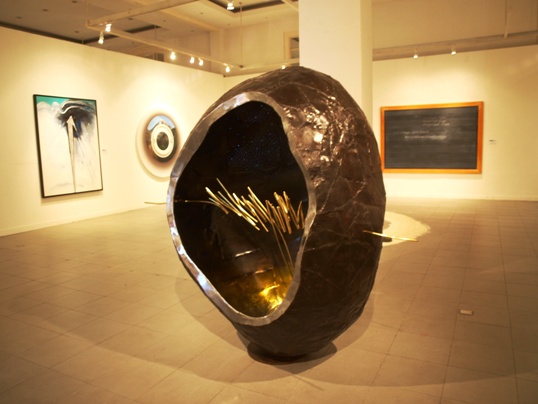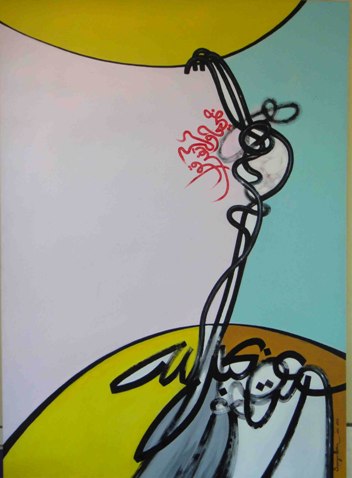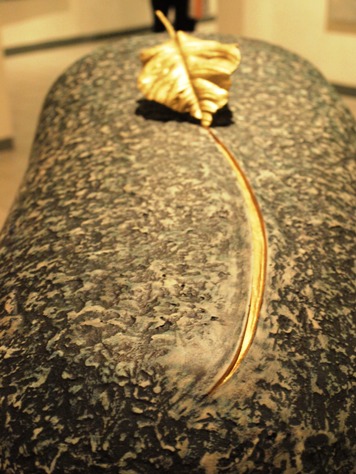Art critics welcome exhibition of edgy works on Islamic themes
Virginia Hooker
During the fasting month of 2011, Indonesia’s national gallery hosted a major exhibition of Islamic art. It was no coincidence that the exhibition was held during Ramadan because the fasting month is also the time for spiritual reflection. The organisers chose the title Bayang (shadows, reflections, illusions) to encourage imaginative creations – in any medium or style – that would invigorate Islamic art. Three hundred artists were invited to participate. Their responses displayed a great diversity of styles, including calligraphic, abstract, and figurative works, executed in a range of media such as painting, installation, sculpture, photography, and new media.
Some of the artists had never previously created Islamically-themed works. Others, like AD Pirous, had established reputations for their religiously-based art. In this way, the exhibition brought together ‘secular’ and ‘religious’ artists with the brief to explore the theme of shadows or reflections. In the invitation, the curators Rizki A Zaelani and A Rikrik Kusmara provided contributors with two questions as starting points: What creates a shadow? How can we understand the nature of a shadow?
Islam in art
The exhibition coincided with the inauguration of Jakarta as the ‘Capital of Islamic Culture in the Asia Region’ for 2011. This provided added stimulus for public discussion about the representation of Islam through art and the significance of the Bayang exhibition. The Yogya-based curator Kuss Indarto blogged that not all the contributing artists found it easy to express the theme in their works in a way that was ‘Islamic’. In his view, this was the reason why several ‘secular’ artists had resorted to painting Qur’anic verses in the belief that this would make the works ‘Islamic’. The result, according to Kuss Indarto, was works lacking in spiritual depth. Some of them even appeared ‘banal’.
A different response was expressed in a substantial review by the critic and artist Yusuf Susilo Hartono published in Visual Arts, the upmarket Jakarta magazine he edits. He identified a strong Islamic theme running through the exhibition. He suggested that the well-known Qur’anic image of the vertical and horizontal ties connecting God with humans and humans with each other (expressed in the Qur’an 3:112) was the inspiration for many of the works.
Diverse images and styles
AD Pirous is arguably Indonesia’s best known living exponent of Islam-inspired art. Since the early 1970s he has created strongly-stated, bold geometric images in dazzling colours, often highlighted with gold leaf and brilliant turquoise. Many of his works feature a verse or phrase from the Qur’an, highlighted by his use of marble paste to raise the Arabic calligraphy and produce a three-dimensional effect.
Ties That Are Firm and Strong reveals Didin Sirojuddin AR’s skills in calligraphy Didin Sirojuddin AR
For this exhibition Pirous contributed a characteristically imposing work featuring the single stroke of the Arabic letter alif, the first in the Arabic alphabet. He entitled it Alif yang menancap bumi dan mencuat ke langit (The alif that is embedded in the earth and shoots up to the sky). The visual impact of the minimalist style arrests the viewer’s attention, and the title brings to mind the divine link between the heavens and this world of human beings.
A similar theme was chosen by master calligrapher and artist, Didin Sirojuddin AR, who expressed it in a radically different style. Sirojuddin is recognised for his mastery of the classical forms of Arabic calligraphy, but for this exhibition he chose an expressive style which he calls ‘contemporary.’ The title of his work, Tali nan kukuh kuat (Ties that are firm and strong), is based on the Qur’anic verses 3:103, ‘And hold fast all together to the Rope of God and be not divided among yourselves.’ To write the verses, Sirojuddin shaped the Arabic letters in forms that resemble ties or ropes. They link the earth and the heavens as they run down the canvas.
Many of the exhibits were eye-catching and boldly executed, but it was Komroden Haro’s Yang Satu (The One), which attracted Yusuf Susilo Hartono’s attention. Well-known for his sculptures, Komroden’s piece in this exhibition was a large, textured bronze capsule topped with a single leaf. Flowing down from the leaf and etched into the capsule is a single line, which can be read as alif. The seed-like capsule combined with the alif suggest the mystery of genesis and the might of Allah. The image would remind Muslims of the Qur’anic verse 6:95, ‘It is God Who causes the seed grain and the date stone to split and sprout.’
Other works in the exhibition seem to express dissatisfaction about the state of Islamic art in Indonesia. Hardiman Rajab’s series of photographs entitled Berakar tapi tak berpucuk (Roots but no growth) is a series of illustrations of human life-stories. Each of them has metaphorical roots but despite this they do not flourish and grow. In his review of the work, Yusuf Susilo Hartono pondered on its meaning. Is it, he wondered, a commentary on the state of modern Islamic art in Indonesia which, although in existence for over 40 years, has failed to thrive?
Neglected development
The Bayang exhibition was the brainchild of Inisaf (Yayasan Senirupa Islam Indonesia, the Indonesian Islamic Art Foundation) in conjunction with the Alumni Association of the Bandung Institute of Technology. Inisaf is concerned about the neglect of Islamic art in Indonesia and aims to redress this by encouraging dynamic Islam-inspired works of art. The group believes that Indonesia’s Islamic culture has the potential to contribute ideas and creative works that will enhance peace, progress and prosperity for all humankind.
Although almost 90 per cent of Indonesians profess Islam, no major art movement has consistently drawn on Islamic themes and images. Many Indonesians still remember the two blockbuster showings of Islamic art in the 1990s held with President Suharto’s backing at the national mosque (the Istiqlal Mosque). Known as Festival Istiqlal I (1991) and Festival Istiqlal II (1995), they were prestigious and highly successful. Festival Istiqlal II attracted 6.5 million viewers, a figure which remains unequalled for attendance at any exhibition of Indonesian art. But the momentum from these exhibitions was not maintained.
Smaller exhibitions of Islam-inspired works have been held regularly since the early 1970s. They featured highly respected artists such as Ahmad Sadali (acknowledged as the pioneer of abstract art in Indonesia), Affandi, Umi Dahlan, AD Pirous, Sunaryo, Didin Sirojuddin AR, Syaiful Adnan, Iwan Tirta and others. But a divide exists between ‘secular’ and ‘religious’ art. Secular works dominate the mainstream art world, while ‘Islamic art’ remains in its own, marginal space. This ‘quarantining’ of Islam-inspired art suggests galleries, dealers, and critics are wary about how to approach and appraise such works.
Image problems
Komroden Haro’s The One attracted critical acclaim at the Bayang exhibition Yusuf Susilo Hartono
There is a widespread perception that Islam prohibits the depiction of living beings. For this reason many artists, art dealers, and the viewing public are anxious that they might be infringing the laws of Islam if they create or view Islam-inspired works. The discussions flowing from the Bayang exhibition included these issues. Writing in the same issue of Visual Arts as the review of the Bayang exhibition, respected scholar Professor Abdul Hadi WM set out the Qur’an’s position on the representation of living beings. He emphasised that the Qur’an does not forbid it. What is forbidden in the Qur’an, he explained, is the creation of objects to be used for worship.
Many of the works of art now regarded as the best examples of classical Islamic civilisation feature images of people, birds, animals and plants. Persian philosophers and religious scholars, Professor Hadi writes in his article, defended the position of art and artists in Islamic cultures, arguing that they did not work from life models. Rather they depicted what they ‘saw’ in their imagination. If, they said, images in a painting are like reflections in a mirror, the real image is not in the mirror, but is stored in the soul of the artist.
Layers of meaning
Muslims approach the Qur’an as a source of unending inspiration. Its language is exceptionally rich in symbolism, allusion, and images of the transcendent power of Allah. Even Arabic calligraphic representations of words of the Qur’an are believed to symbolise some of the qualities of Allah. The circle and the straight line, the essential components of Arabic calligraphy, are especially rich in meaning and both shapes appear in many of the exhibits. The circle, symbol of perfection and unity, without beginning or end, is a reminder of the Oneness of Allah (tawhid), Islam’s fundamental principle. The straight line of the alif is believed to have been created by a ray of light and is imbued with creative energy.
Kuss Indarto gave special praise to one of the Bayang exhibits that uses the circle and a set of sculptures to remind viewers of the impermanence of the material world. Entitled ‘Last Journey’ by its creator, Gabriel Aries, it featured a large circle of marble dust, within which were placed stone sculptures of a pair of shoes and a suitcase. Kuss Indarto interprets this as a representation of the steps we take on the journey from this life to the next, and the baggage of this transitory world that accompanies us on the journey. When we pass from this life, however, the baggage will be left behind, as insubstantial as the shadow of human existence.
Invigorating Islamic art?
The Bayang exhibition was a showcase for contemporary Islam-inspired art in Indonesia. It attracted works from talented and well-known artists and stimulated discussion about the nature of Islamic art and the representation of spirituality in visual forms. The curators’ choice of shadows and reflections as the exhibition’s theme was an inspired one. Not only does it reference the shadow-puppet play traditions of the archipelago, it also draws on the Qur’anic metaphors of light (Allah) and reflected light (His creation). Whether the exhibition and the discussions it generated will result in renewed creative energy in Islam-inspired art remains to be seen. What is clear is that critical responses to the exhibition express respect for those artists who try to engage their viewers in deeper levels of thought using imagery that is neither arcane nor banal.
Virginia Hooker (Virginia.Hooker@anu.edu.au) is Emeritus Professor and Fellow in the School of International, Political and Strategic Studies, College of Asia and the Pacific, The Australian National University. She thanks Yusuf Susilo Hartono, Editor in Chief of Visual Arts, for permission to quote material and use images from the magazine (Volume 8, #50, September-October 2011).














